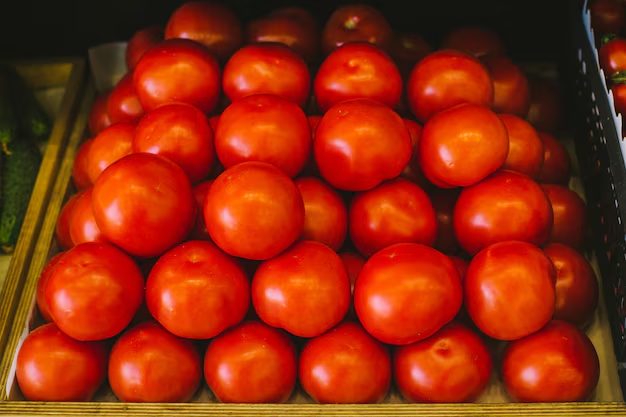Should You Refrigerate Tomatoes? Exploring Best Practices for Storage and Freshness
In the realm of kitchen debates, one question stands out: "Should tomatoes be refrigerated?" While some adamantly argue for leaving them on the countertop, others swear by keeping them cool in the fridge. This guide delves into the nuances of tomato storage, helping you keep your tomatoes fresh and flavorful.
🍅 The Tomato’s Journey: From Vine to Kitchen
Understanding Tomatoes
Tomatoes, whether you classify them as fruits or vegetables, are universally loved and incredibly versatile. They're celebrated for their juicy texture and rich flavor, enhancing dishes ranging from salads to spaghetti sauces. The key to enjoying their fullest taste begins with understanding how best to store them once they're in your kitchen.
Ripening Process
Tomatoes continue to ripen after being picked, primarily due to a natural plant hormone called ethylene. Left at room temperature, tomatoes undergo this ripening process, allowing them to develop their signature taste and texture. Herein lies the debate of refrigeration vs. countertop storage.
🏡 On the Counter vs. In the Fridge: Making the Choice
Pros and Cons of Countertop Storage
Storing tomatoes at room temperature is often recommended for tomatoes that you intend to eat soon. This method allows them to ripen evenly and maintain their natural juiciness.
Benefits:
- Enhanced flavor as tomatoes ripen naturally.
- Optimal texture is achieved without external cold interruptions.
Drawbacks:
- Shorter shelf life; tomatoes may spoil faster in warm climates.
Pros and Cons of Refrigeration
For longer-term storage, the refrigerator becomes a viable option, though not without potential downsides.
Benefits:
- Extends shelf life, especially for fully ripened tomatoes.
- Protects from mold and decay in humid environments.
Drawbacks:
- Refrigeration can alter texture, leading to a mealy consistency.
- May mute the flavor profile slightly.
🍽️ Tips for Optimal Tomato Storage
Identify Ripeness
- Unripe tomatoes: Keep on the counter until fully ripened.
- Ripe tomatoes: Store in the fridge to slow further ripening, but use soon for best flavor.
Use a Breathable Container
- When refrigerating, place tomatoes in a breathable container to prevent excess moisture build-up.
Consider the Temperature
- Refrigerators should be set to a temperature slightly above freezing to protect fruit texture while keeping it cool.
Experiment Based on Use
- If you’re making a sauce or dish where texture isn’t key, refrigeration might not affect your dish’s quality.
🥗 How Refrigeration Affects Tomato Flavor
Tomatoes possess volatile compounds that contribute to their flavor, many of which are adversely affected by cold temperatures. Refrigeration can lead to a reduction in these compounds, mildly impacting the taste. However, once removed from the refrigerator, allowing tomatoes to come back to room temperature can partially restore their flavor.
Tip: Allow refrigerated tomatoes to sit out for a bit before using them in meals to enhance their taste and texture.
🍳 Practical Application: Tomato Use Cases
Consider the variety of tomatoes you have:
- Cherry and Grape Tomatoes: Due to their small size and thicker skin, these can withstand refrigeration slightly better than larger varieties.
- Vine-Ripened Tomatoes: Often more sensitive to cold, benefiting from room temperature storage if they’re yet to fully ripen.
- Heirloom Varieties: Known for their flavor, best enjoyed after ripening on the counter.
🍕 Anecdotal Insights and Consumer Practices
Different households have varied practices, often influenced by the local climate and personal preference. Some consumers find that refrigeration helps reduce food waste, especially when managing large quantities. Others swear by the robust flavor of counter-ripened tomatoes, echoing culinary experts and home cooks who prefer maximal flavor delivery.
In warmer regions, kitchens might see more benefit from chilling, while cooler areas might indulge fully in the room-temperature method. With evolving culinary practices and regional preferences, tomato storage has become both a science and an art.
📋 Summary of Tomato Storage Best Practices
🍅 For Unripe/Just Ripened Tomatoes:
- Store on the counter to allow for complete ripening and flavor development.
🔁 Transitioning from the Fridge:
- Allow 30 minutes to 1 hour at room temperature before use.
🧊 Refrigeration (for fully ripe ones not immediately needed):
- Use a breathable container or vegetable drawer.
- Ideal for humid climates or when extending shelf life.
🍽️ When Preparing Meals:
- Utilize softer, vine-ripened varieties right after ripening.
- Chillier climates benefit from longer countertop ripening.
🪴 Bringing It Together
So, should you refrigerate tomatoes? It turns out the answer is not one-size-fits-all. Depending on your needs, how quickly you consume them, and your kitchen’s environmental conditions, you may find a tailored approach works best. Embrace the experimentation — your taste buds will guide you right. Remember, the journey of enjoying tomatoes in their prime is as vibrant as the fruit itself.
